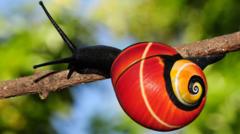Can Snails' Beauty Lead to Their Salvation?

Saving the Polymita Tree Snails: A Race Against Time
The Polymita tree snails, often hailed as one of the world's most beautiful mollusks, are facing an existential crisis. These colorful snails, native to Eastern Cuba, are not just remarkable for their vibrant, patterned shells but also serve as a compelling subject for scientific study. Unfortunately, their striking appearance has made them highly sought after by collectors, driving several species toward extinction. In light of this, researchers are embarking on an urgent mission to save these snails and unlock their biological secrets. This article delves into the threats facing the Polymita snails, the efforts being made to conserve them, and the intriguing scientific questions that remain unanswered about these unique creatures.
The Beauty and the Threat
Polymita snails are renowned for their vibrant and extravagantly patterned shells, which showcase a kaleidoscope of colors. The most endangered species, Polymita sulphurosa, features a striking lime green shell adorned with blue flame patterns and bright orange and yellow bands. This beauty, however, comes with a price tag; collectors are often drawn to these shells, exacerbating the snails' decline. The irony is palpable: the very characteristics that make these snails fascinating to scientists and enthusiasts alike are the same traits that place them in jeopardy.
Conservation Efforts in Action
In response to the alarming trend of Polymita snails heading toward extinction, a collaborative effort has been initiated by biologists in Cuba and specialists from the University of Nottingham in the UK. This partnership aims to study the snails' evolutionary history while developing strategies for conservation. Prof Angus Davison, an evolutionary geneticist and mollusc expert at the University of Nottingham, is at the forefront of this research.
Prof Davison emphasizes the importance of understanding the genetic makeup of these snails. "We aim to use this information to confirm how many species there are, how they are related to each other, and what part of their genetic code contributes to their extraordinary, unique color patterns," he explains. By uncovering these biological secrets, the research team hopes to create a framework for conservation efforts that can help protect the snails from extinction.
The Challenges of Conservation
While the scientific research is well underway, conservationists face several challenges in their mission. One significant hurdle is the illegal shell trade, which remains difficult to regulate despite international rules protecting Polymita snails. The Convention on International Trade in Endangered Species (CITES) prohibits the export of these snails and their shells from Cuba without a permit. However, the sale of shells is legal in many other countries, creating a loophole that fuels the demand for these endangered creatures.
Prof Davison warns, "With pressures like climate change and forest loss affecting their natural habitat in Cuba, you can easily imagine where people collecting shells would tip a population over into local extinction." This scenario underscores the urgent need for effective conservation strategies that can adapt to evolving threats.
Captive Breeding and Genetic Research
One of the most promising aspects of the conservation project involves captive breeding efforts spearheaded by Prof Bernardo Reyes-Tur at the Universidad de Oriente in Santiago de Cuba. Despite facing logistical challenges such as unreliable power supplies and extreme heat, Prof Reyes-Tur has taken Polymita snails into his own home to nurture them in a controlled environment. "They have not bred yet, but they're doing well," he reports, addressing the difficulties of maintaining ideal conditions for their growth and reproduction.
Meanwhile, at the University of Nottingham, advanced genetic research is being conducted. The team is utilizing cryogenic freezers to preserve tiny samples of snail tissue, enabling them to analyze the snails' genomes. This genetic data will provide valuable insights into the evolutionary history of the Polymita species, offering clues about their unique adaptations and vulnerabilities.
The Evolutionary Mystery of Color
The striking colors of Polymita snails present a fascinating evolutionary mystery. Why have these snails evolved such vibrant and diverse patterns? Understanding the biological basis for their coloration may not only shed light on their evolution but also inform conservation strategies. The research team aims to identify the genetic components responsible for these colors, thereby enhancing our understanding of how these snails have adapted to their environment.
Future Directions for Conservation
The collaborative efforts between Cuban and UK researchers represent a significant step toward ensuring the survival of Polymita snails. By combining genetic research with on-the-ground conservation strategies, the team hopes to create a comprehensive approach that addresses both immediate threats and long-term survival. This includes raising public awareness about the importance of these snails and the need to protect their habitats from deforestation and climate change.
Furthermore, establishing breeding programs and habitat restoration initiatives will be crucial in rebuilding Polymita populations. Conservationists are also exploring ways to engage local communities in protecting these snails, recognizing that sustainable practices can benefit both the environment and the people who depend on it.
Conclusion: A Call to Action
The plight of the Polymita tree snails serves as a poignant reminder of the delicate balance between human interests and the natural world. While their beauty captivates collectors, it is essential to recognize the impact of our actions on vulnerable species. Researchers and conservationists are working tirelessly to unlock the secrets of these extraordinary snails and ensure their survival for future generations.
As we reflect on the efforts to save the Polymita snails, we must also consider our role in conservation. How can we promote awareness and protect these magnificent creatures from extinction? The journey to save the Polymita snails is a collective responsibility that requires our attention and action.
FAQs
What are Polymita tree snails?
Polymita tree snails are a group of colorful and vibrantly patterned snails native to Eastern Cuba. They are known for their striking shells, which come in various colors and designs.
Why are Polymita snails endangered?
Polymita snails are endangered primarily due to habitat loss, climate change, and illegal shell trade. Their beautiful shells make them highly desirable to collectors, contributing to their decline.
What is being done to conserve Polymita snails?
Conservation efforts include genetic research to understand the snails' evolutionary history, captive breeding programs, and raising awareness about the threats they face. Collaborations between Cuban and international researchers are crucial for these efforts.
How can individuals help in the conservation of Polymita snails?
Individuals can help by spreading awareness about the importance of protecting these snails, supporting conservation organizations, and refraining from purchasing shell products that may contribute to illegal trade.
As we contemplate the future of Polymita tree snails, we invite you to consider: How can we collectively contribute to preserving the beauty of our natural world? #Conservation #PolymitaSnails #Biodiversity
Published: 2025-08-04 00:54:40 | Category: world



